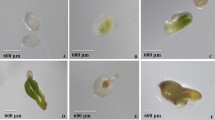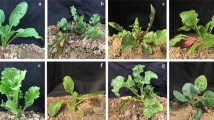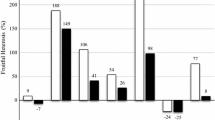Abstract
For the purpose of obtaining yellow-flowered evergreen azaleas, single and three-way interspecific crosses between evergreen azaleas and Rhododendron japonicum f. flavum were compared. In single cross, although many seeds were obtained from R. eriocarpum × R. japonicum f. flavum, the seedlings from immature ovule were albino or pale-green plants. They were withered away at acclimation. In R. kiusianum × R. japonicum f. flavum, green seedlings were observed, but number of ovules contained in one capsule was very small. In three-way cross, (R. kiusianum × R. eriocarpum) × R. japonicum f. flavum, many viable seeds were contained in one capsule, and about 15% of the seedlings were green leaf colored. These results suggest that three-way cross is one of the useful breeding methods for creating the new yellow-flowered evergreen azalea. Isozyme analysis revealed that most of seedlings were zygotic origin without distinction of their leaf colors, but some green seedlings indicated the same genotypes as the seed parents. Therefore, it is important to confirm hybridity of the seedlings by isozyme technique.
Similar content being viewed by others
References
Akabane, M., 1993. On the cross compatibility F1-plants (Rhododendron kiusianumMak. × R. indicumSweet) × R. japonicumSuringer. J Japan Soc Hort Sci 62 (Suppl. 1): 344-345 (in Japanese).
Akabane, M., A. Yamanaka, D. Takashima, T. Nakatsue & Y. Nakamura, 1971. On the fertility of interspecific crossing and the growth of F1 seedlings in rhododendron species. Bull Tochigi Pref Agri Expt St 15: 95-102 (in Japanese).
Anderson, W.C., 1984. A revised tissue culture medium for shoot multiplication of rhododendron. J Amer Soc Hort Sci 109: 343- 347.
Burk, L.G., 1967. An interspecific bridge-cross. J Hered 58: 215- 218.
Chaparro, J.X., R.G. Goldy, B.D. Mowrey & D.J. Werner, 1989. Identification of Vitis viniferaL. × Muscadinia rotundiforiasmall hybrids by starch gel electrophoresis. HortScience 24: 128-130.
Heursel, J., 1981. Diversity of flower colors in Rhododendron simsiiPlanch. and prospects for breeding. Euphytica 30: 9-14.
Kehr, A., 1985. Hybridizing azaleas. In: Fred C. Galle (Ed.), Azalea, pp 337-346. Timber Press, Portland, Ore.
Kunishige, M. & Y. Kobayashi, 1980. Chromatographic identification of Japanese azalea species and their hybrids. In: Contributions toward a Classification of Rhododendrons, pp 277-287. The New York Botanic Garden, New York.
Miyahara, K., I. Miyajima & E. Matsuo, 1993. Phylogenic relationships between Rhododendron sataenseNakai and other wild evergreen azaleas in Kyushu by isozyme analysis. J Japan Soc Hort Sci 62 (Suppl. 2): 412-413 (in Japanese).
Parfitt, D.E., S. Aruksekar & D.W. Ramming, 1985. Identification of plum × peach hybrids by isoenzyme analysis. HortScience 20: 246-248.
Poysa, V., 1990. The development of bridge lines for interspecific gene transfer between Lycopersicon esculentumand L. peruvianum. Theor Appl Genet 79: 187-192.
Wendel, J.F. & C.R. Parks, 1982. Genetic control of isozyme variation in Camellia japonica L. J Hered 73: 197-204.
Wendel, J.F. & N.F. Weeden, 1989. Visualization and interpretation of plant isozymes. In: D.E. Soltis & P.S. Soltis (Eds.), Isozymes in Plant Biology, pp. 46-72. Diosorides Press, Portland, Ore.
Williams, E.G., R.B. Knox & J.L. Rouse, 1982. Pollination subsystems distinguished by pollen tube arrest after incompatible interspecific crosses in Rhododendron(Ericaceae). J Cell Sci 53: 255-277.
Williams, E.G. & J.L. Rouse, 1988. Disparate style lengths contribute to isolation of species in Rhododendron. Aust J Bot 36: 183-191.
Yamaguchi, S., 1986. In-vitroculture of remote hybrid seedlings aiming to breed new yellow flowered evergreen azalea. Plant Cell Incompatibility Newslett 18: 50-51.
Yamaguchi, S., M. Kunishige & T. Tamura, 1985. Interspecific compatibility in Japanese rhododendrons. Bull Veg & Ornam Crop Res Stn Japan, Ser B, No. 8: 87-97 (in Japanese with English summary).
Author information
Authors and Affiliations
Rights and permissions
About this article
Cite this article
Ureshino, K., Miyajima, I. & Akabane, M. Effectiveness of three-way crossing for the breeding of yellow-flowered evergreen azalea. Euphytica 104, 113–118 (1998). https://doi.org/10.1023/A:1018661004467
Issue Date:
DOI: https://doi.org/10.1023/A:1018661004467




